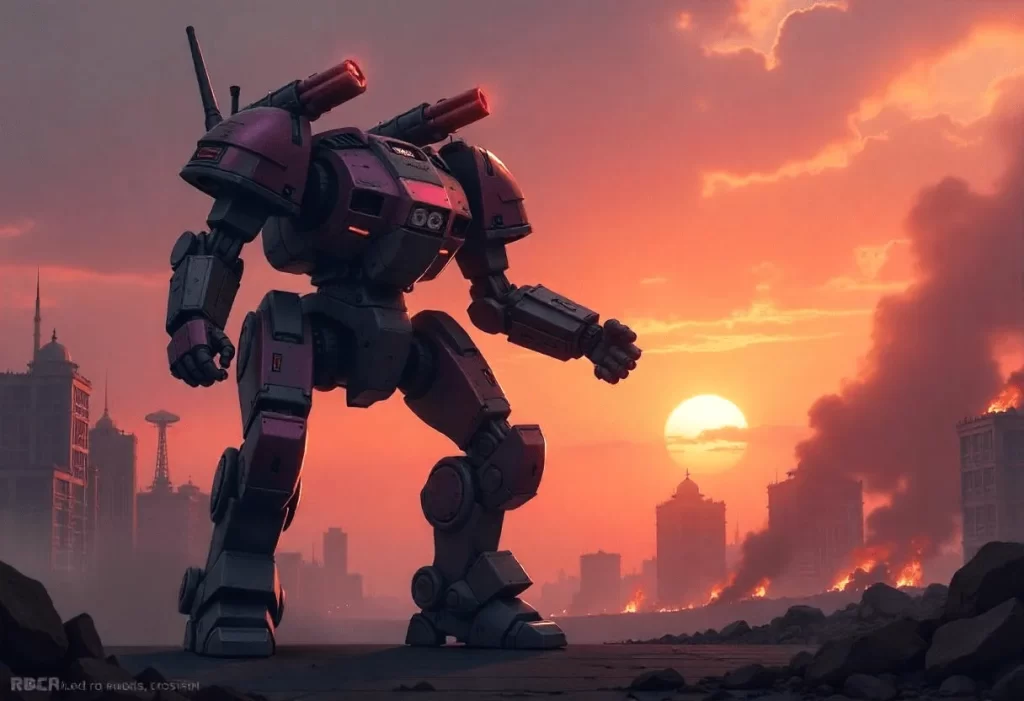
armored core VI
🧠 Introduction to Armored Core VI
Armored Core VI: Fires of Rubicon is not just a return — it’s a resurrection. After nearly a decade in stasis, FromSoftware has brought its legendary mech combat franchise back to life in spectacular fashion. Fires of Rubicon is the quintessential mech experience for both people who have played mech games before and those who have never played them before. It combines high-octane action with intricate customization, strategic depth, and a backdrop that is eerily evocative.
In a world reeling from war and corporate greed, you step into the cockpit of a customizable Armored Core VI (AC) unit to battle across a hostile planet filled with secrets and devastation. From agile skirmishes in the sky to brutal ground encounters, the game’s fast-paced combat and deep tuning options create one of the most satisfying gameplay loops in recent memory.
Whether you’re a diehard fan of the series or someone completely new to mech games, Armored Core VI is crafted to immerse you — and challenge you — from the moment you boot it up. In this article, we’ll break down 15 reasons why Fires of Rubicon is not only one of the best mech games ever made, but a shining example of what modern gaming can be when passion meets precision.
Let’s go into the essential components that make this game an absolute necessity to experience.
🔥 1. The Legacy of the Armored Core VI Series
The Armored Core VI series began back in 1997 on the original PlayStation. Known for its intricate mech customization, punishing difficulty, and mission-based gameplay, it quickly developed a loyal fan base. Unlike other action games of its era, Armored Core VI was centered on providing players with complete control over their machine, including the ability to customize everything from the internal systems to the weapon loadouts and even the leg positions.
Throughout the years, the series has developed while still preserving its fundamental character. With each entry, FromSoftware refined the formula, culminating in Armored Core V in 2012. After that, the series went quiet — until now.
With Fires of Rubicon, FromSoftware has successfully modernized the franchise while honoring its roots. This is not merely a resurrection; rather, it is a reinvention.
🚀 2. FromSoftware’s Bold Return to Mech Warfare
FromSoftware’s recent legacy has been defined by Dark Souls, Bloodborne, Sekiro, and Elden Ring. These critically acclaimed action RPGs helped redefine difficulty and design in gaming. But before any of that, FromSoftware made its mark with Armored Core VI.
The cruel and devastating intensity of Soulsborne games is merged with the high-speed, gear-heavy action of conventional Armored Core VI games in Fires of Rubicon, creating a game that seems like a fusion of the two universes. What is the end result? A game that encourages precision, experimentation, and flexibility while ever compromising on the fun part of the experience.
It’s a love letter to long-time fans and a perfect entry point for new players. With modern graphics, streamlined menus, and intuitive controls, FromSoftware has ensured that Fires of Rubicon appeals to a new generation without alienating its core audience.
🌍 3. The Storyline: War, Rubicon, and Ruin
Playing the game, which takes place on the war-torn planet Rubicon 3, players are thrust into a fight that is fueled by greed, technology, and the need to survive. Corporations, mercenaries, and resistance forces all clash over a mysterious energy source known as Coral — a substance with the potential to either save or destroy civilizations.
You play as a Raven — As the conflict escalates, a freelance pilot finds himself caught in the center of it all. Providing a multifaceted and immersive experience that gradually unfolds as you accomplish contracts, the narrative is conveyed through a combination of mission briefings, audio transmissions, and environmental storytelling.
Similar to the desolate environment that can be seen in Elden Ring, Rubicon exudes an eerie ambience that permeates the entire place. The ruined cities, scorched skies, and shattered relics of past conflicts create a somber yet captivating backdrop to your battles.
🎮 4. Gameplay Overview: What Makes It Tick
From the very first mission, Armored Core VI hooks you with its kinetic combat and precise control. Missions are designed to test different playstyles — from high-speed dogfights in the air to tactical ground assaults against towering mechs.
– Mission-Based Combat Revamped
Each mission offers a unique challenge: infiltrate enemy bases, eliminate rival mercenaries, or protect convoys under heavy fire. Objectives vary, keeping the pace fresh and encouraging you to adjust your mech accordingly.
Replay value is incredibly high thanks to the combat rating system and multiple branching paths, giving players a reason to return with different builds and strategies.
– World Design and Structure
Rubicon is divided into distinct zones, each with its own hazards, enemies, and terrain challenges. You’re not exploring a seamless open world, but each mission space is vast, dynamic, and dense with tactical possibilities.
Verticality plays a major role — you’re just as likely to be dodging missiles mid-air as you are crouching behind ruined structures for cover.
🛠️ 5. Customization That Changes the Game
One of the most iconic and defining features of the Armored Core VI franchise has always been its mech customization — and Fires of Rubicon elevates that concept to new heights. FromSoftware has designed a robust and nuanced system that allows players to create their ultimate war machine, piece by piece. This isn’t just cosmetic tinkering — every component affects how your AC (Armored Core VI) handles, fights, and survives.
🧩 Core Parts and Loadouts
Customization begins at the foundational level: selecting your AC’s core components. Each of the four main parts — head, core, arms, and legs — plays a critical role in defining your mech’s stats, from AP (Armor Points) to mobility and energy efficiency.
Heads: Affect target acquisition, scan range, and visual data processing.
Cores: The central structure that governs overall defense, weight capacity, and cooling.
Arms: Determine weapon compatibility and aiming stability.
Legs: Perhaps the most game-changing component, with multiple types like bipeds (balanced), reverse-joints (jump height), tetrapods (hover mobility), and tank treads (high weight capacity but low agility).
These base components must be synergized to complement your desired combat style.Are you looking for a sniper build with a fast energy recharge and a great range? You’ll need lightweight parts and efficient generators. Prefer heavy assault with dual chainguns and a shoulder-mounted missile pod? When this is the case, tank legs and high-capacity cores are the best options.
🔧 Weapon Choices and Modifications
Weapon loadouts are where the real experimentation begins. Each arm and shoulder can carry different weapons, and there’s a wide array to choose from:
Rifles & Pulse Guns: Great for mid-range combat with balanced energy use.
Bazookas & Grenade Launchers: Devastating at close to mid-range but require good timing.
Laser Blades & Energy Swords: Ideal for aggressive, close-quarters builds, this weapon is lethal but dangerous.
Missile Pods & Drones: Ideal for crowd control or keeping mobile enemies at bay.
What makes Fires of Rubicon stand out is how dramatically these weapons change the flow of battle. Choosing a lightweight frame with a shotgun and pulse blade turns the game into a melee brawler. Equipping dual sniper cannons on a floating tetrapod? Now you’re a hovering death dealer raining precise hell from above.
Every build feels viable — and unique. And the sheer number of combinations (hundreds of parts and weapons) ensures there’s always something new to try. No two ACs ever feel the same, and that’s part of the magic.
⚙️ Inner Parts and Tuning
Beyond external components, inner parts such as the generator, booster, and FCS (Fire Control System) give fine control over your mech’s capabilities:
Boosters: Impact dash speed, jump height, and thrust recovery.
FCS: Provides a balance between lock-on speed, range, and the ability to target multiple targets, which is essential for long-range builds or swarm management.
These internal systems let players push their ACs to extremes. Want lightning-fast aerial evasion? Invest in lightweight boosters and a fast-recovering generator. Want to tank damage and keep pressing forward? Maximize defense and explosive power while sacrificing maneuverability.
📈 Why Customization Matters So Much
Customization in Armored Core VI is more than just personalization — it’s strategic. The game encourages experimentation and adaptation through a combination of mission variety and escalating difficulty. A build that works brilliantly in one level might fall short in the next, requiring players to rethink their approach.
This constant balancing act between power, speed, energy, and weight is the soul of the Armored Core VI experience. Unlike many modern shooters or action games, there’s no one-size-fits-all “meta.” Success depends on your ability to read the battlefield and adapt your machine to the threats ahead.
Better yet, players can save multiple loadouts, making it easy to switch between styles based on the challenge. There’s even a test arena where you can try out new builds before committing to a mission. Armored Core VI
🎮 New Player Friendly — But Still Deep
For those new to the series, the idea of tuning dozens of mech parts might sound overwhelming. But FromSoftware has made the system far more approachable this time around. The user interface is clean and intuitive, with stats explained in clear, readable terms.
In addition, there are pre-built loadouts available for players who like to get started quickly, and the game gradually incorporates more complex elements as you continue through it. Veterans will find all the depth they crave, while newcomers won’t be lost in a sea of parts and numbers. Armored Core VI



